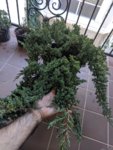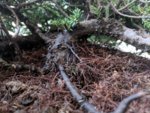@mmp77
First - do no harm. I often will let a tree sit on the bench for a year or two before I do anything. This happens most often with trees that have many options.
Getting rid of unattractive parts is not bad advice, remove a little, then leave it grow until ''inspiration strikes''.
Look for branches that are too straight, these can be pruned short, with the stubs left to be turned into jin, deadwood.
An exercise, that can help,,
Examine the tree multiple times, using only one criteria for picking the ''front'', and make a temporary mark, be it chalk or toothpick, or bamboo skewers. When done with the exercise you will have 3 or 4 markers in the pot, sometimes, sometimes all different sides of the tree, sometimes several will like up on the same side.
Look at the nebari, avoid looking at anything but the nebari. Mark the front based on the best nebari, using either chalk mark on the pot, or a toothpick stuck in pot, or some other temporary marker.
Then go back and look at the tree, looking for the best trunk line - mark with a different stick or color chalk on the pot.
Then do back and look for the best ''unique feature'' and mark the front where this is best visible.
Then go back and focus on branches,, and where the current branches would make the best front, mark that.
WHen all done, if you are lucky, the majority of your markers will be on the same side of the tree. Then you know that side is your best candidate for front. Then you need to decide which feature should be the main driver for deciding how to style the tree. Pick the best asset of the tree, and design to take advantage of that.
Let this process take time. Or repeat the process several times before beginning to remove branches. Repeat the process months apart. Then when you feel confident you have identified the tree's best features, it is time to style the tree. Don't rush.

















